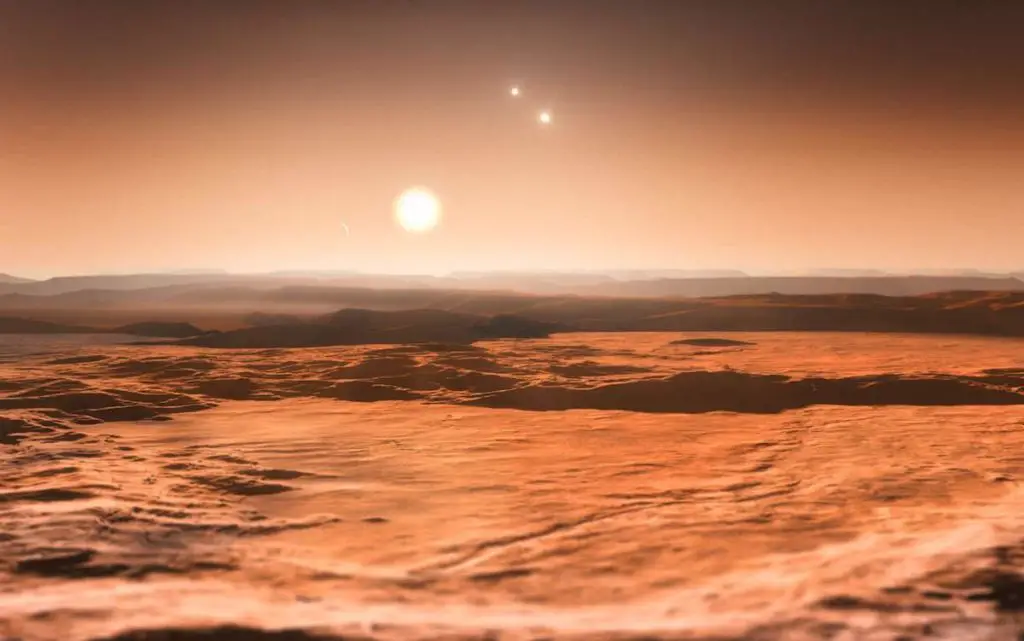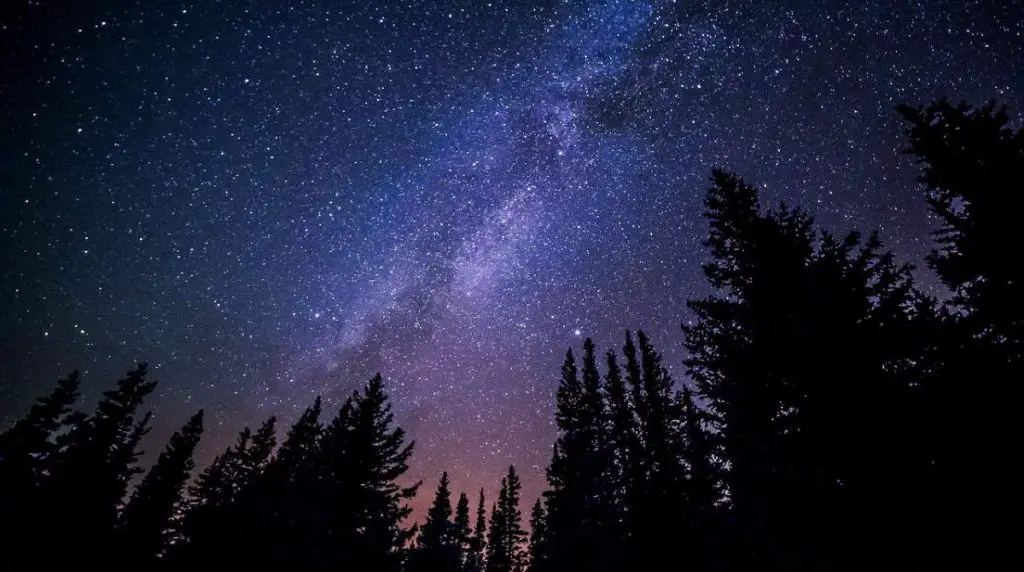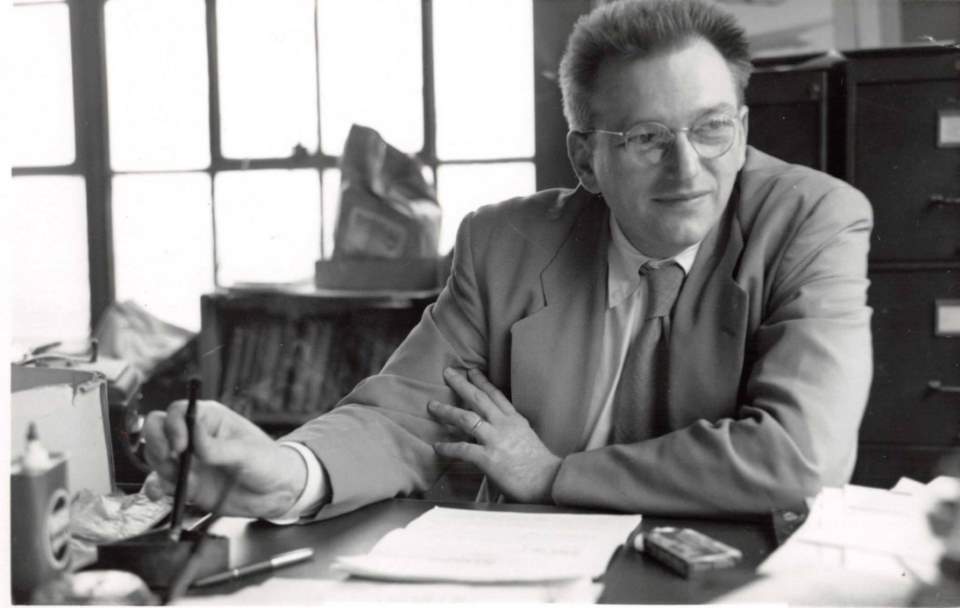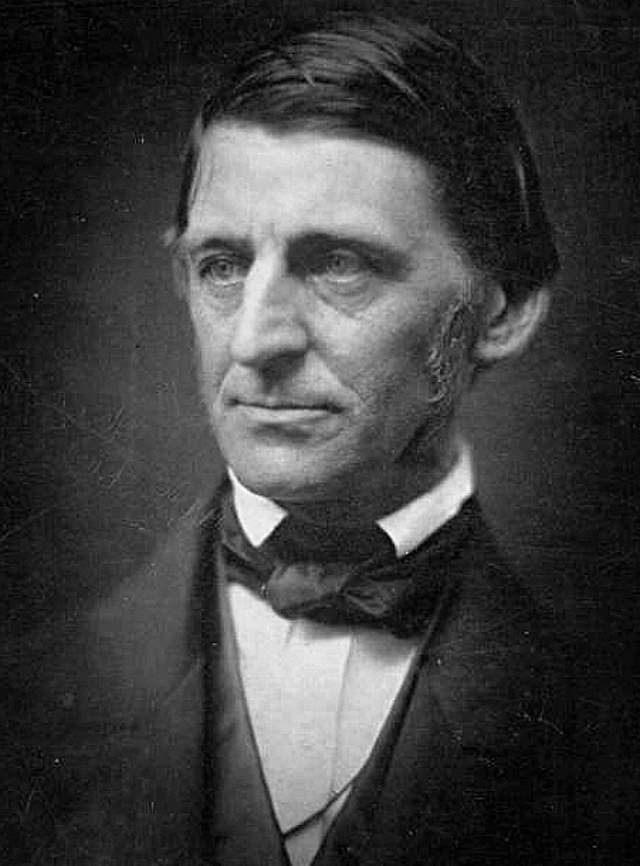Can a planet have three suns? In March 2016, astronomers from the Harvard-Smithsonian Center for Astrophysics discovered a Jupiter-sized hot planet with three suns: KELT-4Ab. The planet orbits the star KELT-4A, in the star system KELT-4 system that is 680 light-years away from us.
A hot Jupiter with three suns

It’s really possible that a planet with more than one star: in March 2016, Astronomers from the Harvard-Smithsonian Center for Astrophysics discovered a Jupiter-sized hot planet orbiting three stars. The system is 680 light-years away from us. In fact, this is the fourth discovery ever of a triple-star system with a planet. So, maybe, this rare phenomenon is more common than we think.
KELT-4Ab is what’s known as a “hot Jupiter,” a category of exoplanets that are similar in characteristics to Jupiter but orbit very close to their host stars. Hot Jupiters typically have high surface temperatures and short orbital periods. In the case of KELT-4Ab, it orbits its primary star, KELT-4A, every three days.
The planet was discovered by the Kilodegree Extremely Little Telescope (KELT). Since it is the fourth planet found in such a system, the system is named KELT-4 and the planet KELT-4Ab. KELT-4A is the brightest host star of the planet. KELT-4BC is a binary star system subcomponent of the triple.
Isaac Asimov’s Nightfall: A story [then novel] about a planet that has multiple suns
On March 17, 1941, John W. Campbell, editor of Astounding Science Fiction, asked Isaac Asimov that: “What, if people see the stars once in a thousand years?” Campbell had read Ralph Waldo Emerson’s (see the title Ralph Waldo Emerson and “Nature” below) 1836 essay “Nature” and Emerson was saying in the first chapter “If the stars should appear one night in a thousand years, how would men believe and adore, and preserve for many generations the remembrance of the city of God!”
Campbell wanted Asimov to read that quote, and asked him the question above, “What
They discussed the matter for a while. Campbell tried to strengthen his idea. Sometimes he asked questions like “What could be the reason that the stars cannot be seen at other times?” And he listened to the answers Asimov trying to produce. Then, he said, “Go home, and write this damned story, in one way or another”.
Asimov wrote the story and named it “Nightfall”. It was published in the September 1941 issue of Astounding Science Fiction and quickly became the most successful story of the young Asimov. In 1968, the Science Fiction Writers of America voted “Nightfall” the best science fiction short story written prior to the 1965 establishment of the Nebula Awards and included it in The Science Fiction Hall of Fame Volume One, 1929-1964.

In 1990, prolific American science-fiction writer Robert Silverberg wrote a novel of the same name, based on Asimov’s story. Asimov wrote: “…Eventually, I received the extended Nightfall manuscript from Bob (Silverberg)… Bob did a wonderful job and I could almost believe I had written the whole thing myself. He remained absolutely faithful to the original story and I had very little to argue with.”
“Nightfall” is a science fiction short story by Isaac Asimov, first published in 1941. The story takes place on the fictional planet of Lagash, which is located in a stellar system with six suns. This unique arrangement means that the sky of Lagash is almost always bright and daytime; true darkness (known as nightfall) occurs only once every 2049 years.
The plot of the story revolves around an impending event of this once-in-millennia nightfall, which is expected to plunge the planet into darkness and lead to widespread chaos. Scientists in the story predict this event based on their understanding of astronomy and the behavior of the six suns. However, their prediction isn’t taken seriously by most of the population. They attempt to prepare for the inevitable chaos, despite the disbelief and disinterest of the general public.

Related: Why the night sky is dark?
When nightfall eventually occurs, the people of Lagash are driven to madness by the sight of the unfamiliar night sky – the stars, an experience entirely alien to them. The story ends with the implication that the civilization of Lagash collapses every 2049 years due to the psychological trauma inflicted by the sight of the night sky, resetting its progress each time.
Asimov’s “Nightfall” is a compelling exploration of the psychological consequences of facing the unknown, and how the constraints of one’s environment can limit the understanding and perception of the universe. In 1968, the Science Fiction Writers of America voted “Nightfall” the best science fiction short story written prior to the establishment of the Nebula Awards in 1965.
In 1990, Asimov collaborated with the American science-fiction writer Robert Silverberg to expand “Nightfall” into a full-length novel, which explores the societal collapse and the aftermath in more detail.
In fact, the chances of these multi-star places being habitable are relatively low, but you never know – maybe somebody out there sees the stars once in a thousand years.
John W. Campbell

John Wood Campbell Jr. (June 8, 1910 – July 11, 1971) was an American science fiction writer and editor. As editor of Astounding Science Fiction (later called Analog Science Fiction and Fact) from late 1937 until his death, he is generally credited with shaping the Golden Age of Science Fiction. Isaac Asimov called Campbell “the most powerful force in science fiction ever, and for the first ten years of his editorship he dominated the field completely.”
Campbell often wrote under the pen name Don A. Stuart.
Under Campbell’s editorship, Astounding Science Fiction became the leading science fiction magazine of its time and played a significant role in shaping what is known as the Golden Age of Science Fiction. His vision for the genre was one that focused on realistic and rigorous extrapolation of science and technology, with well-developed characters and thoughtful exploration of societal implications.
Campbell’s influence on the field of science fiction extended beyond his editorial work. He often provided feedback to authors, influencing their writing and ideas. For example, he’s credited with inspiring Isaac Asimov’s “Three Laws of Robotics“ and with shaping Robert A. Heinlein’s and Arthur C. Clarke’s early careers. He was also instrumental in fostering the careers of other notable authors, including A.E. van Vogt, Theodore Sturgeon, and Lester del Rey, among others.
While Campbell’s impact on science fiction is undeniable, his legacy is complex. His later years were marked by support for controversial and pseudoscientific ideas, and he expressed views on race and slavery that have been criticized. Nonetheless, his long tenure as editor of Astounding/Analog and his role in shaping the Golden Age of Science Fiction have left a lasting imprint on the genre.
Ralph Waldo Emerson and “Nature”

Ralph Waldo Emerson (May 25, 1803 – April 27, 1882) was an American essayist, lecturer, and poet who led the Transcendentalist movement of the mid-19th century. He was seen as a champion of individualism and a prescient critic of the countervailing pressures of society, and he disseminated his thoughts through dozens of published essays and more than 1,500 public lectures across the United States.
In “Nature”, Emerson put forth the foundation of transcendentalism, a belief system that espouses a non-traditional appreciation of nature. Transcendentalism suggests that the divine, or God, suffuses nature, and suggests that reality can be understood by studying nature. Emerson’s visit to the Muséum National d’Histoire Naturelle in Paris inspired a set of lectures he later delivered in Boston which were then published.
Within the essay, Emerson divides nature into four usages: Commodity, Beauty, Language, and Discipline. These distinctions define the ways by which humans use nature for their basic needs, their desire for delight, their communication with one another, and their understanding of the world. Emerson followed the success of “Nature” with a speech, “The American Scholar”, which together with his previous lectures laid the foundation for transcendentalism and his literary career.
Sources
- Nightfall (Asimov short story and novel) on Wikipedia
- KELT-4Ab on Wikipedia
- John W. Campbell on Wikipedia
- Ralph Waldo Emerson on Wikipedia
- Nature (essay) on Wikipedia
- How Many Elephants are Left in the World in 2025? - August 17, 2025
- Moon Landings: All-Time List [1966-2025] - February 2, 2025
- What Is Max-Q and Why Is It Important During Rocket Launches? - January 16, 2025
